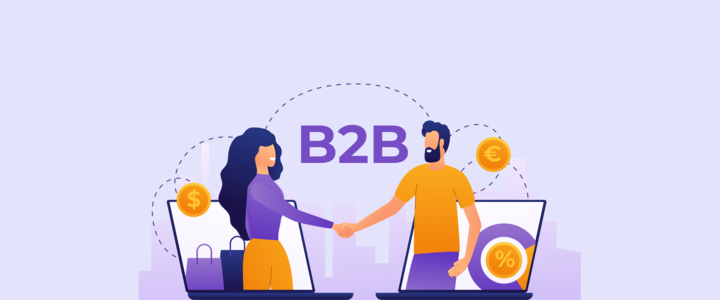Customer retention rates of B2B loyalty programs yield up to 13% higher profits compared to businesses without structured reward systems.
Coupled with the fact that 82% of B2B companies report significantly higher profits from loyal customers, it’s clear that loyalty programs for B2B businesses are becoming essential.
This guide will show you everything about B2B loyalty programs —how they work, the different types available, successful examples, and the best practices.
Increase your ROI upto 20X by rewarding your loyal customers with points and discounts using WPLoyalty’s loyalty program.
What is a B2B loyalty program?
A B2B loyalty program is a reward system where businesses reward their business customers for their partnership and encourage them to make repeat purchases.
Unlike consumer loyalty programs, B2B loyalty initiatives focus on long-term business relationships, bulk purchasing behaviors, and organizational decision-making processes.
These programs typically reward: Long-term partnerships, purchase volume and frequency, channel partner performance, distributor engagement, business referrals, digital engagement and training completion.
For example, if you’re a software distributor, your B2B loyalty program might reward resellers for:
- Hitting quarterly sales targets
- Completing product certification training
- Bringing in new client referrals
- Maintaining consistent order volumes
- Participating in beta testing programs
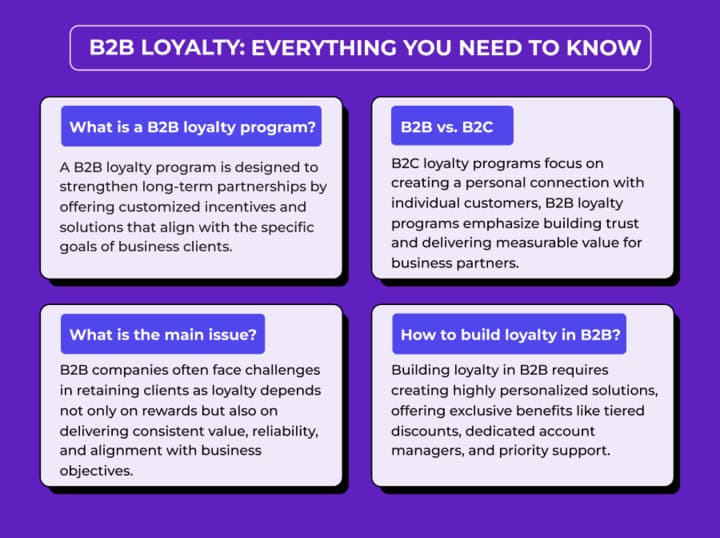
How do B2B loyalty programs work?
B2B loyalty programs work on a value-multiplication principle, where both parties benefit from increased engagement.
Let’s look at a practical example:
A manufacturing company’s B2B customer loyalty program might work like this:
- Distributors earn 2 points per $1000 in purchases
- Additional points for early payments (+10%)
- Bonus points for stocking new product lines (+500)
- Tier status unlocked at point thresholds:
- Silver: 10,000 points (2% rebate)
- Gold: 25,000 points (3.5% rebate + priority shipping)
- Platinum: 50,000 points (5% rebate + dedicated account manager)
Key Differences Between B2B and B2C Loyalty Programs
| S.No | Aspect | B2B Loyalty Programs | B2B Loyalty Programs |
| 1. | Target Audience | Businesses (e.g., distributors, resellers, partners) | Individual consumers |
| 2. | Purchase Size | High-value, bulk orders | Smaller, frequent purchases |
| 3. | Decision Process | Involves multiple stakeholders, longer cycles | Single decision-maker, quicker decisions |
| 4. | Goals | Build long-term partnerships, drive repeat business | Encourage frequent purchases, build brand loyalty |
| 5. | Rewards | Volume discounts, rebates, exclusive deals | Points, discounts, freebies |
| 6. | Engagement | Focus on trust, tailored communication | Focus on emotional connection and convenience |
| 7. | Complexity | Customizable and tailored per client | Simple and standardized |
Do B2B Loyalty Programs Really Work? [Statistics & ROI]
The short answer is a resounding yes – B2B loyalty programs have been proven to deliver tangible, measurable benefits for businesses that implement them effectively. Let’s look at some key statistics:
- B2B companies with effective loyalty programs see 30% higher share-of-wallet from their top customers. (Loyalty360)
- 75% of B2B customers say loyalty programs positively influence their purchasing decisions. (Merkle)
- 56% of B2B loyalty programs are or will be configured for multiple brands. (Comarch)
- B2B companies with loyalty programs see a 10–20% increase in annual revenue. (Worldmetrics)
Looking at return on investment (ROI), B2B loyalty programs can deliver impressive results.
An insight by 212f found that B2B companies with a conservative estimate of a 2:1 ROI, every dollar invested in the program returns $2 to your business from your customers.
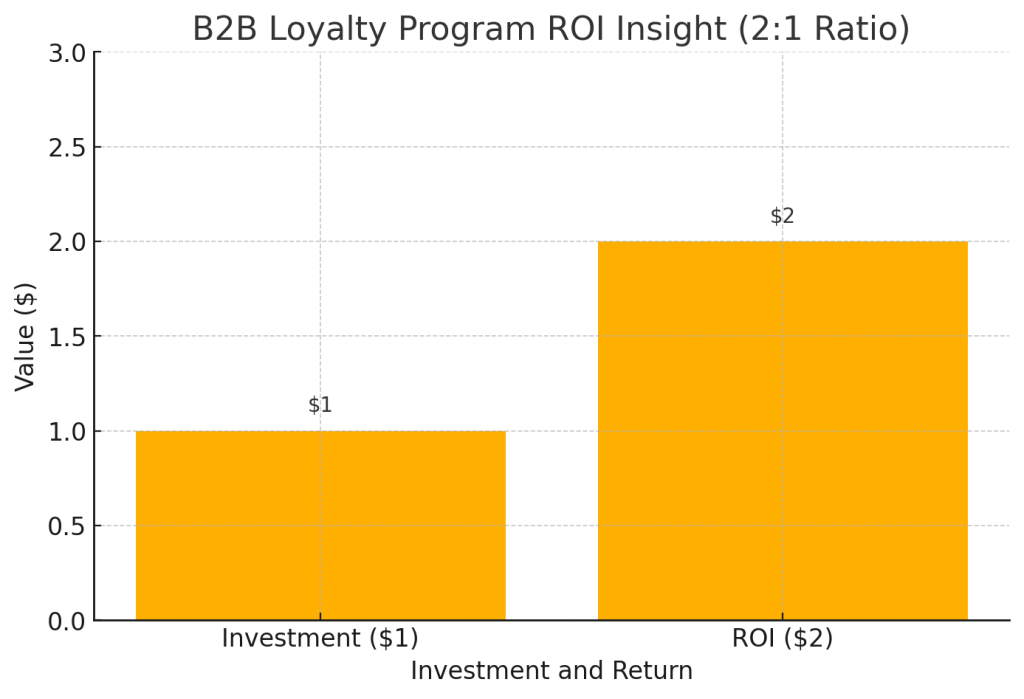
Types of B2B Loyalty Programs
B2B loyalty programs come in a variety of forms, each designed to address the unique needs and dynamics of the commercial customer landscape.
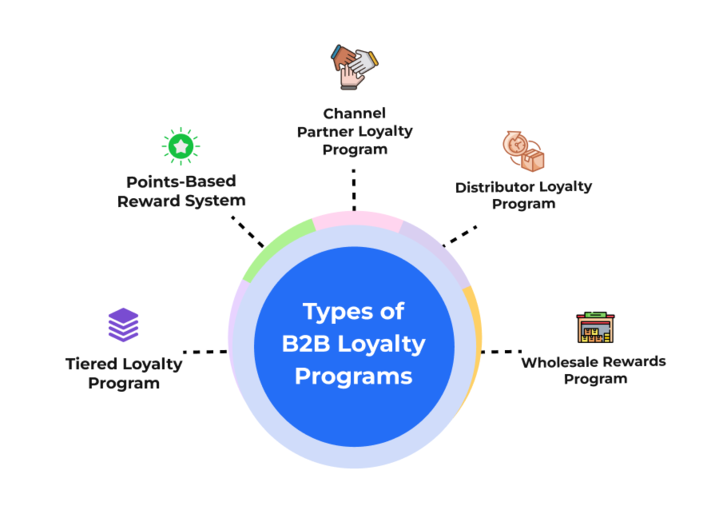
The popular types of B2B Loyalty Programs:
- Tiered Loyalty Programs: Tiered loyalty programs categorize customers into different levels based on their engagement or purchase volume. Each tier offers progressively better rewards.
- Points-Based Reward Systems: In a points-based system, customers earn points for various actions, which they can later redeem for rewards. Points can be awarded for purchases, early payments, participating in promotions, or referring new clients.
- Channel Partner Loyalty Programs: These programs are designed specifically for channel partners like resellers, integrators, or consultants who sell your products or services.
- Distributor Loyalty Programs: Distributor programs focus on strengthening relationships with wholesalers and distributors who play a critical role in the supply chain.
- Wholesale Rewards Programs: Aimed at businesses that purchase goods in bulk, wholesale rewards programs incentivize continued and increased purchasing.
Best Rewards for B2B Customer Loyalty Programs
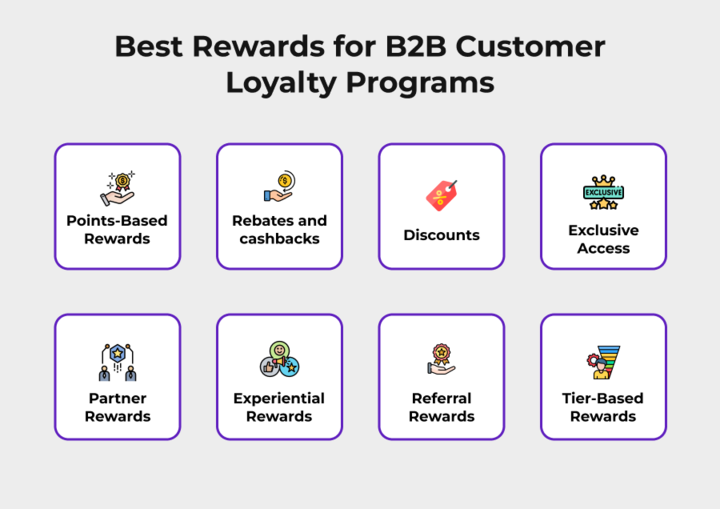
B2B loyalty programs offer a variety of rewards to acquire and retain customers, including:
Points-Based Rewards
Customers earn points for actions like purchases, referrals, or completing surveys. These points can be redeemed for rewards such as discounts, free products, or exclusive services.
Example: A corporate office supplies company implements a points-based loyalty program where business customers earn 1 point for every $100 spent. Points can be redeemed for discounts on future purchases or for free products from a rewards catalog.
- Scenario: A law firm regularly purchases office supplies, spending around $5,000 monthly. Over six months, they accumulate 300 points. They redeem these points for a $300 discount on a large order of ergonomic chairs, reducing their costs.
Rebates and cashbacks
Customers receive cash back or rebates based on their purchase volume. These financial incentives can be used toward future purchases or credited to their account
Example: An industrial equipment manufacturer offers a 2% cashback on total annual purchases exceeding $100,000. At the end of the fiscal year, customers receive the cashback as a credit note, which they can apply to future purchases or services.
- Scenario: A construction company spends $150,000 on equipment over the year. They receive a $3,000 credit, which they use to offset the cost of maintenance services, encouraging continued business with the manufacturer.
Volume Discounts
Customers receive special pricing or volume discounts, encouraging them to make larger purchases or continue buying from your business.
Example: A packaging supplier offers businesses a discount structure based on order quantity. If a client orders between 1,000 to 5,000 units, they receive a 5% discount. For orders exceeding 5,000 units, the discount increases to 10%. This incentivizes clients to place larger orders to benefit from cost savings.
- Scenario: A retail chain needs packaging materials for their products. By ordering 6,000 units instead of 4,000, they save more per unit due to the volume discount, encouraging them to consolidate their orders with this supplier.
Exclusive Access
Clients gain access to special events, product previews, industry insights, or educational resources. Offering exclusive access adds value to the partnership.
Example: A software company provides its top-tier clients with early access to new software features and beta programs. These clients can implement and benefit from the latest advancements before they’re released to the broader market.
- Scenario: An IT firm gains early access to new cybersecurity features, allowing them to enhance their service offerings to their own clients ahead of competitors.
Partner Rewards
Customers receive branded merchandise, gift packages, or other bonus items as a “free bonus” along with their orders.
Example: A technology company offers partner rewards to its resellers and system integrators. Partners earn rewards based on sales performance, certifications achieved, and participation in marketing initiatives. Rewards include market development funds (MDF), lead sharing, and higher margin opportunities
- Scenario: An IT consulting firm partners with the technology company and achieves a Gold Partner status by meeting sales targets and certifying their staff. As a result, they receive priority access to sales leads, additional discounts on products, and co-marketing funds to promote joint services
Experiential Rewards
Clients enjoy personalized experiences like member-only events, workshops, or employee perks such as free movie passes.
Example: A premium industrial equipment manufacturer offers experiential rewards such as invitation-only events, factory tours, and exclusive networking opportunities with industry experts for their top clients.
- Scenario: A large construction firm is invited to an exclusive annual summit hosted by the equipment manufacturer. At the event, they participate in hands-on demonstrations of upcoming products, attend workshops on industry trends, and network with other key players.
Referral Rewards
Customers receive incentives for referring new clients to your business, such as discounts, credits, or exclusive services. It is done to increase word-of-mouth marketing through trusted recommendations.
Example: A logistics company launches a referral program where existing business clients receive a $500 account credit for every new customer they refer who signs up for services exceeding a certain value.
- Scenario: A retail chain refers a fellow retailer to the logistics company. After the new client signs a contract, the referring retail chain receives a $500 credit, which they apply to their next invoice.
Tier-Based Rewards
Customers move up through different levels or tiers based on their purchase volume or engagement, unlocking more valuable rewards at each level.
Example: An office furniture manufacturer implements a tier-based loyalty program with three levels: Bronze, Silver, and Gold. Clients are placed in tiers based on their annual purchase volume, with each tier offering escalating benefits.
- Bronze Tier (up to $50,000/year):
- Standard pricing
- Basic customer support
- Silver Tier ($50,001 – $150,000/year):
- 2% discount on all orders
- Priority customer support
- Access to new product previews
- Gold Tier (over $150,000/year):
- 5% discount on all orders
- Dedicated account manager
- Customized products
- Free installation services
- Scenario: A corporate interior design firm increases their annual purchases to reach the Gold Tier. They now enjoy a 5% discount on all orders, saving significant costs. The dedicated account manager provides personalized service, and free installation reduces project expenses, making the manufacturer their preferred supplier.
Reward your customers with multiple rewards like points, discounts, free shipping, freebies for various customers actions using WPLoyalty pre-built campaigns
5 Best B2B Loyalty Program Examples
1. The Microsoft Partner Program
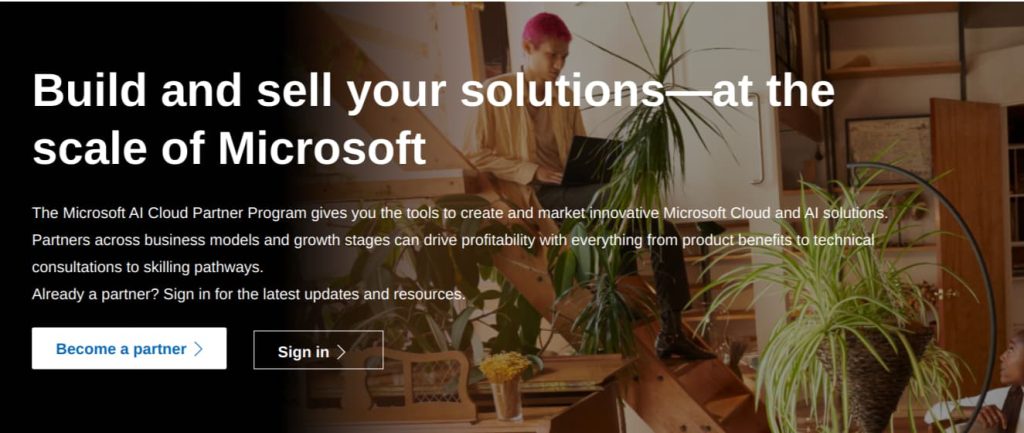
Microsoft Partner Program (now called Microsoft Cloud Partner Program as of October 2022) is actually one of the most successful B2B loyalty programs. The program offers:
- Resources: Access to tools, programs, and an ecosystem of potential customers and ongoing support
- Training and support: Exclusive training, support, service, and sales offerings
- Membership levels: Three types of memberships (Action Pack, Silver, Gold), each with a set of benefits to help your business grow
- Program options: The Microsoft Device Partner Program supports partners who want to include devices in their customer solutions
- Partners in Learning: Encourages new approaches to teaching and teacher professional development
To join the program, you can:
- Provide business details, like your organization’s address and legal point of contact
- Validate your credentials
- Confirm your credentials and unlock your membership through time-sensitive instructions sent to your business email
You can enroll in the program by:
- Going to Partner Center
- Following the enrollment instructions
2. The Salesforce Partner Program
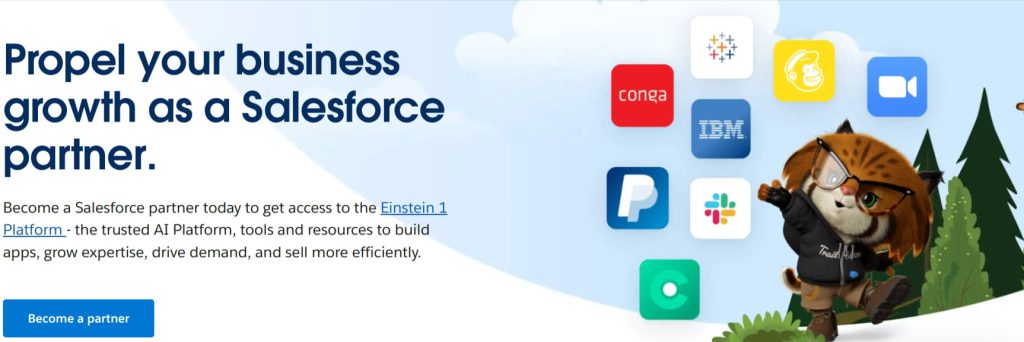
The Salesforce Partner Program is a network of experts that helps partners develop and implement Salesforce solutions for clients. The program offers a variety of benefits, including:
- Resources: Access to tools, training, and certification to help partners develop expertise in specific industries, product areas, and business functions
- Events: Opportunities to participate in local, global, and digital events
- Collaboration: Opportunities to collaborate with other Salesforce partners and customers
- Learning: Access to Trailhead, a free online learning platform
- Blogs: Access to tips and insights from experts
- AppExchange: Independent software vendors (ISVs) can build and sell solutions on AppExchange, the leading enterprise cloud marketplace
To join the program, you can:
- Complete the Due Diligence Questionnaire (Consulting, MSP, Reseller) or submit your Business Plan for the AppExchange (ISV)
- Accept the Salesforce Partner Program Agreement (SPPA)
- Complete onboarding and training
You can enroll in the program by:
- Going to Salesforce Partner Community
- Entering your Salesforce credentials via partner portal
3. Caterpillar’s customer loyalty program
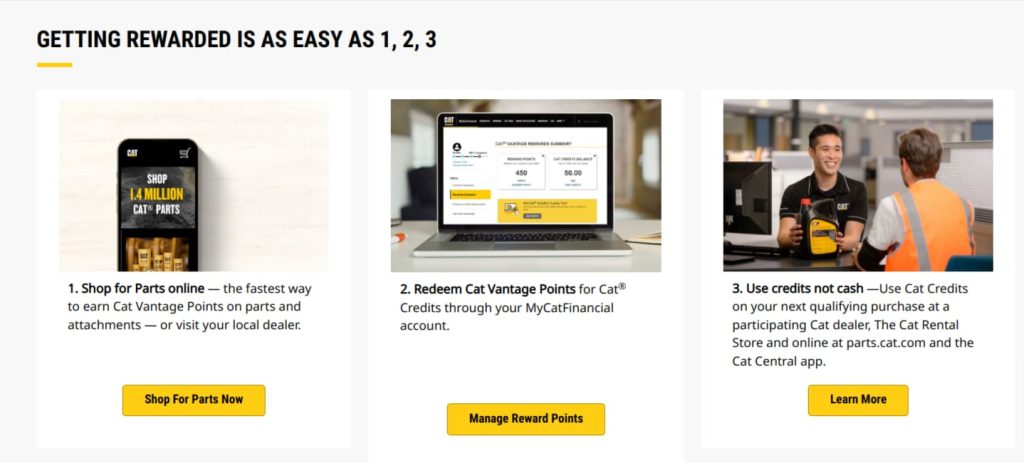
Caterpillar’s “Cat Vantage Rewards” program is intended to reward Caterpillar customers and as a means for the Sponsor to express its appreciation for customers’ interest in the Caterpillar brand. The program offers:
- Points on every purchase: Earn points on every dollar spent on parts, services, or equipment
- Multiple ways to earn: Earn 3% reward points on the first $15,000 spent per year on parts.cat.com and the Cat Central app
- Flexible rewards options: Choose how and when to use your points for parts, services, or rentals
- Cat Card benefits: Includes a dedicated customer service team, no annual fee, and competitive rates
- Online account management: Manage your account online at MyCatFinancial.com or through the MyCatFinancial app
You can enroll in the program by:
- Visiting parts.cat.com or the Cat Central app to sign up.
- Selecting your dealer and following the prompts
4. IBM’s VIP Rewards & Know Your IBM Program

IBM has a few B2B loyalty programs, including VIP Rewards and Know Your IBM (KYI), that are designed to engage customers and partners, and help IBM grow its revenue.
VIP Rewards
A program that uses gamification to encourage customers to participate in activities that earn points. Customers can then redeem points for rewards like gift cards or training sessions with IBM experts.
Know Your IBM (KYI)
A program that rewards IBM business partners for learning about IBM products and services, and selling IBM solutions. KYI has two components:
- Learn and earn: Participants earn points for completing online learning modules.
- Sell and earn: Participants earn points for selling IBM products and services.
- Rewards: Points can be redeemed for gifts from participating merchants, exclusive training resources, and special event access.
To join IBM’s B2B loyalty programs, you can:
- Join IBM Partner Plus
- Participate in Know Your IBM (KYI)
5. Celebrity Cruises
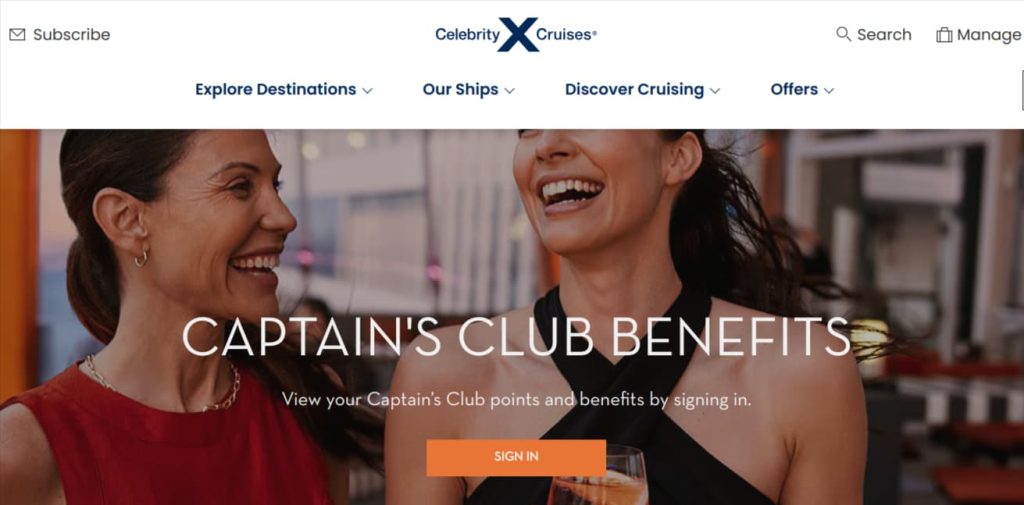
Celebrity Cruises’ B2B loyalty program, Captain’s club, is a travel industry program that incentivizes travel agencies to sell Celebrity Cruises trips. The program offers:
- Points: Travel agencies earn 500 points for each cruise trip they sell.
- Cash incentives: Agents can exchange 2,500 points for cash with a Celebrity Rewards Mastercard.
- Individual rewards: Each agent receives their own points, encouraging healthy competition.
You can enroll in the program by:
- Downloading the Celebrity Cruises mobile application
- Visiting the Celebrity Cruises Website
How to Build a B2B Loyalty Program?
To create a successful B2B customer loyalty program:
- Identify Clear Objectives and KPIs
- Set specific goals like increasing repeat purchases, reducing churn, retaining customers, or encouraging additional purchases through upselling and cross-selling.
- Define key performance indicators such as repeat purchase rate, average order value, customer lifetime value, and program engagement rate (e.g., reward redemption rate).
- Understand Your Customers Deeply
- Segment your clients by purchase volume, industry, or engagement level to tailor the program effectively.
- Gather insights through surveys, feedback, and purchase history analysis to reward loyal customers aligned with buying patterns.
- Design a Compelling Value Proposition
- Choose relevant rewards like points-based rewards, rebates and cashbacks, exclusive access, partner rewards, or experiential rewards.
- Align rewards with client goals, such as offering training programs if clients value skill development or providing marketing support if they aim to grow their customer base.
- Select the Right Loyalty Program Structure
- Decide on a points-based system, tiered program, or hybrid model that fits your business and customer preferences.
- Ensure the structure is straightforward and encourages desired customer behaviors, making it easy for clients to understand how they can earn and redeem rewards.
- Develop Reward Earning and Redemption Mechanics
- Define how clients earn rewards—through purchases, referrals, completing surveys, or engaging with your content.
- Set redemption options including monetary rewards (discounts on future purchases), non-monetary rewards (exclusive services, training), or customizable rewards that clients can choose based on their needs.
- Integrate Technology for Seamless Management
- Choose a loyalty software platform with features like customizable reward structures, integration with your existing CRM/ERP systems, real-time analytics to manage your loyalty program.
- Ensure data security and compliance with regulations like GDPR to protect client information and build trust.
- Launch and Promote the Program
- Use multi-channel communication like customized email campaigns, personalized outreach, and social media to introduce the program to your clients.
- Highlight the value proposition by emphasizing how the program solves customer pain points, adds value to their business, and strengthens the partnership.
Best Practices for B2B loyalty programs
Here are the best practices for B2B loyalty programs:
- Keep the loyalty program straightforward.
- Make earning and redeeming rewards easy.
- Provide clear terms and conditions about how the program works.
- Offer relevant rewards that align with business needs.
- Implement tiered rewards for different customer segments.
- Implement strategic reward expiration policies
- Create partner-specific training and certification programs
- Establish clear ROI measurement frameworks
- Implement B2B reward bundling
- Encourage and act on customer feedback.
How to Set Loyalty Program KPIs?
Establishing Key Performance Indicators (KPIs) helps you measure the success of your loyalty program. Consider the following metrics:
- Customer Retention Rate
Measures the percentage of customers who continue to do business with you over a specific period. - Repeat Purchase Rate
Tracks how often customers make additional purchases after joining the program. - Average Order Value (AOV)
Observes changes in the average transaction amount to see if the program encourages larger purchases. - Engagement Levels
Assesses participation rates, such as active members and reward redemptions. - Customer Lifetime Value (CLV)
Calculates the total revenue expected from a customer throughout their relationship with your company. - Referral Rates
Monitor how often current customers refer and acquire new customers to your business.
How to Structure B2B Loyalty Rewards?
- Align Rewards with Business Goals
Ensure the rewards you offer support your objectives, such as increasing sales of a particular product line. - Offer Tiered Rewards
Implement a tier system where customers unlock more valuable rewards as they increase their engagement or purchase volume. - Provide Flexible Redemption Options
Allow customers to choose from a variety of rewards to increase satisfaction and perceived value. - Incorporate Non-Monetary Benefits
Offer exclusive access, training, or other value-added services that enhance the customer relationship. - Set Expiration Dates Wisely
Encourage timely engagement without causing frustration by setting reasonable expiration periods for rewards.
How to Overcome Common B2B Loyalty Challenges?
- Low Customer Engagement
- Solution: Enhance the value proposition of your rewards and personalize communication to make the program more appealing.
- Complex Program Design
- Solution: Simplify the program rules and make the user experience intuitive.
- Integration Issues with Existing Systems
- Solution: Choose loyalty software that seamlessly integrates with your current CRM and ERP systems.
- Measuring ROI
- Solution: Establish clear KPIs from the outset and use analytics tools to track performance accurately.
- Maintaining Program Relevance
- Solution: Regularly update rewards and program features based on customer feedback and industry trends.
- Resource Constraints
- Solution: Start with a scalable program and automate processes where possible to reduce the burden on your team.
Get started with WPLoyalty’s easy-to-use loyalty campaigns and reward your loyal customers easily.
Wrapping Up
B2B loyalty programs are powerful tools for building stronger relationships with your business customers. When done right, they can boost customer retention, increase sales, and create lasting partnerships. The key is to keep your program simple, offer meaningful rewards, and make it easy for customers to participate.
Whether you’re starting a new loyalty program or improving an existing one, remember to focus on what your business customers really want. Use the right technology, track your results, and keep improving based on feedback.
With careful planning and the right approach, your B2B loyalty program can become a valuable asset that helps your business grow and keeps your customers coming back.
Frequently Asked Questions
You can build B2B customer loyalty by:
1. Creating a clear, easy-to-use loyalty program
2. Providing excellent customer service
3. Offering valuable rewards and incentives
4. Maintaining consistent communication
5. Delivering high-quality products/services
6. Building strong personal relationships
7. Providing educational resources and training
The key B2B loyalty statistics are:
1. 5% increase in customer retention can boost profits by 25-95% (Bain & Company)
2. 84% of B2B customers join loyalty programs (Merkle)
3. Loyal B2B customers spend 67% more than new ones (Accenture)
4. B2B companies with loyalty programs see 30% higher customer retention (Loyalty360)
5. 75% of B2B buyers base purchasing decisions on customer experience (Accenture)
The most effective ways to promote B2B customer loyalty are:
1. Implement a well-structured loyalty program
2. Provide exceptional customer service
3. Offer personalized experiences
4. Deliver consistent value
5. Maintain regular communication
6. Recognize and reward loyal customers
7. Address issues promptly and effectively
B2B customer lifetime value varies by industry but typically:
1. Average B2B customer relationship lasts 4-6 years
2. B2B customers spend 5-10 times more than B2C customers
3. Typical B2B customer lifetime value ranges from $20,000 to $200,000+
4. Enterprise B2B relationships can exceed millions in lifetime value
The two biggest factors that determine customer loyalty customer experience and value perception.
